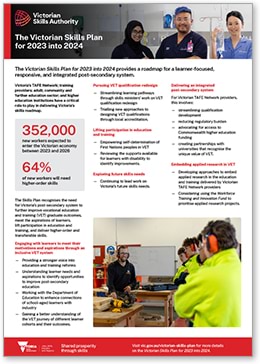This fact sheet provides summary information about the Victorian Skills Plan 2023 into 2024 specifically related to registered training organisations (RTOs).
You can download a PDF copy or read an accessible version below.
Also see our other fact sheets related to the plan.
Downloadable RTO fact sheet
(opens in a new window)
Accessible RTO fact sheet
The Victorian Skills Plan for 2023 into 2024 provides a roadmap for a learner-focused, responsive, and integrated post-secondary system
Victoria’s TAFE Network; training providers; adult, community and further education sector; and higher education institutions have a critical role to play in delivering Victoria’s skills roadmap.
Key statistics from the Victorian Skills Plan for 2023 into 2024
- 352,000 new workers expected to enter the Victorian economy between 2023 and 2026
- 64% of new workers will need higher-order skills.
The skills plan recognises the need for Victoria’s post-secondary system to further improve vocational education and training (VET) graduate outcomes, meet the aspirations of learners, lift participation in education and training, and deliver higher-order and transferable skills.
Engaging with learners to meet their motivations and aspirations through an inclusive VET system
- Providing a stronger voice into education and training reforms
- Understanding learner needs and aspirations to identify opportunities to improve post-secondary education
- Working with the Department of Education to enhance connections of school-aged learners with industry
- Gaining a better understanding of the VET journey of different learner cohorts and their outcomes.
Pursuing VET qualification redesign
- Streamlining learning pathways through skills ministers’ work on VET qualification redesign
- Trialling new approaches to designing VET qualifications through local accreditation.
Lifting participation in education and training
- Empowering self-determination of First Nations peoples in VET
- Reviewing the supports available for learners with disability to identify improvements.
Exploring future skills needs
- Continuing to lead work on Victoria’s future skills needs.
Delivering an integrated post-secondary system
For Victorian TAFE Network providers, this involves:
- streamlining qualification development
- reducing regulatory burden
- advocating for access to Commonwealth higher education funding
- creating partnerships with universities that recognise the unique value of VET.
Embedding applied research in VET
- Developing approaches to embed applied research in the education and training delivered by Victorian TAFE Network providers
- Considering using the Workforce Training and Innovation Fund to prioritise applied research projects.
Updated


